The leaves of palm trees are decorative, both for their green tones and for their wider or thinner shapes but always elongated or even elongated but united to form a palm or more rounded leaf. Discover types of indoor palm trees in this article.
If you want to decorate your home with an eye-catching plant that dresses up empty spaces without needing a lot of care, we are going to tell you which are the indoor palm trees that can be useful for you. Also, we have included more information on how to care for indoor palms, where you will see basic tips such as what fertilizer for indoor palms you should use to start growing them at home.
Table of Contents
Types of Indoor Palm Trees – Full List
Chamaedorea elegans or Parlour Palm
We begin our listing of one of the most popular species used for interior decoration. Parlour palm (Chamaedorea elegans) has forked leaves of light green color that can tend to grayish, very similar to bamboo leaves. Although they do not usually grow more than 10 ft (3 m) high, it is advisable to take this into account when deciding on this type of indoor palm tree. Its cultivation in a pot is very simple, you only have to place it in a place where it receives indirect sunlight and give it regularly.

Phoenix roebelenii or Dwarf Palm Tree
Another of the indoor ornamental palms is also known as the dwarf palm (Phoenix roebelenii) although it can reach almost 16 ft (5 m) in height when planted in soil and a large place.
Normally, this type of palm tree will grow about 6.5 ft (2 m) maximum and will need to be placed in a well-lit place and receive 2 doses of watering per week. This well-known palm does not tolerate waterlogging so you must be careful and make sure that the container where you grow it has good drainage.
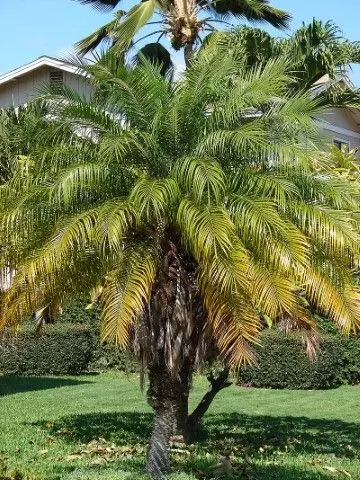
Dypsis lutescens or Areca Palm
One of the types of indoor palms that is capable of dividing into several stems. Its height is usually about 10 ft (3 m) maximum, but specimens have been known to reach up to 20 ft (6 m). As with the previous species, also known as bamboo palm, it needs to be in a well-lit place, but away from drafts. As for watering the areca palm (Dypsis lutescens), you will only have to water it twice a week at the most and 3 times if the summer has begun.
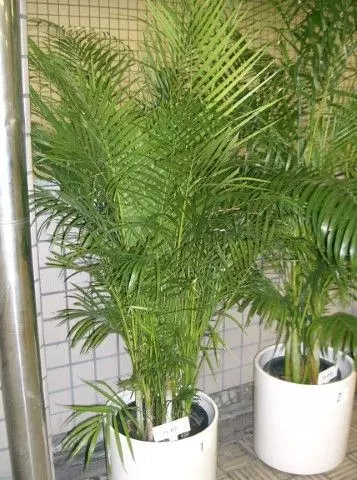
Archontophoenix alexandrae or Alexandra Palm Tree
There is a variety of Alexandre palm (Archontophoenix alexandrae) that can be grown in pots. This palm, native to Australia, has greenish pinnate leaves on the upper side and glaucous on the underside. It is one of the most valued decorative indoor palms for its inflorescences and its reddish fruits. It needs several doses of watering per week as it does not tolerate drought. Likewise, it is also important to make sure to keep it in a well-drained container and to place it in a semi-shaded spot.
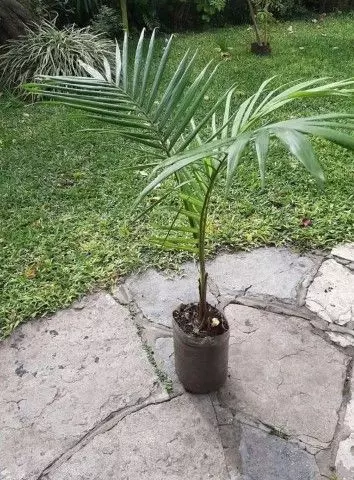
Howea forsteriana or Kentia Palm
Although the kentia palm (Howea forsteriana) is a palm tree capable of reaching a height of 49 ft (15 m), it can also be grown in pots since its stem is not usually more than 6” (15 cm) thick. It is a slow-growing species that needs to be placed in a place where it receives sunlight for at least a few hours a day. However, remember that if you leave it exposed for too long it could lose the color of its leaves and suffer burns on them. Water it 1 to 2 times a week.
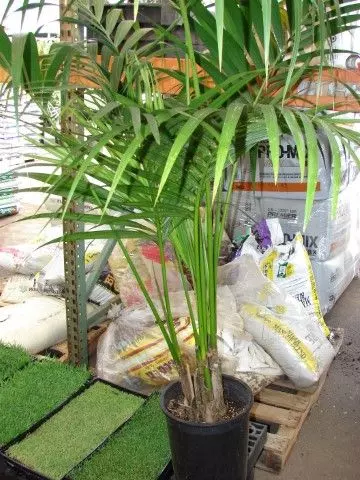
Adonidia merrillii or Manila Palm
Its common name, Manila Palm (Adonidia merrillii). Capable of growing up to 16 ft (5 m) and with a stem of about 10” (25 cm) thick, this slow-growing indoor palm needs little care to grow optimally throughout the year: water it moderately and place it in a place where it does not receive direct sunlight.
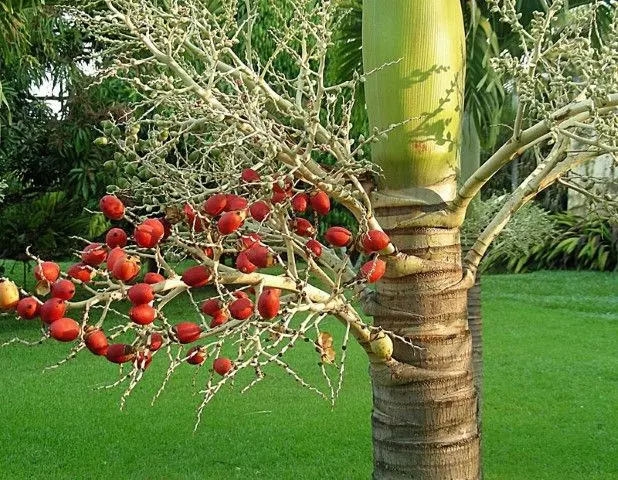
Caryota mitis or Fishtail Palm
Coming from Southeast Asia, it is one of the small indoor palms most used to decorate spaces and give our home an exotic touch due to its curious dark green and shiny leaves. The fishtail palm (Caryota mitis) in a pot does not usually exceed 6.5 ft (2 m) in height. It does not tolerate frost either, so we recommend that you place it in a humid place where it receives direct sunlight.
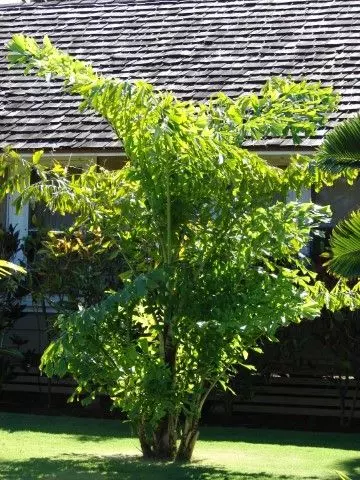
Licuala grandis or Palas Palm
The indoor palm tree is commonly known as Palas Palm and scientifically known as (Licuala grandis), is also slow-growing, it does not usually exceed 10 ft (3 m) in height and has a stem no more than 2” (6 cm)thick. We recommend that you place it in a lighted and spacious place, as well as giving it at least twice a week and increasing the dose during the summer months.
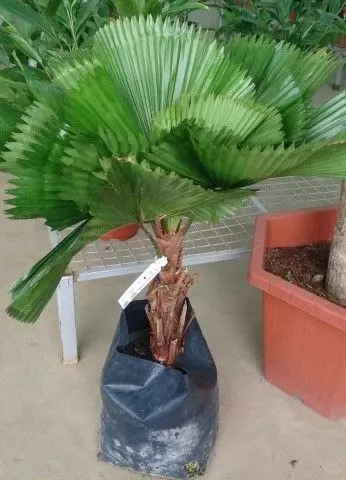
Raphis excelsa or Bamboo Palm
Another of the indoor palm species with multiple stems. The maximum height of the Bamboo Palm (Raphis excelsa) is usually about 16 ft (5 m), has palmate leaves, and prefers a well-lit location. You just need to be sure to grow it in a well-drained container and give it away at least twice a week.

Cocos nucifera or Coconut Tree
We finish our list with the palm tree known as coconut tree (Cocos nucifera), perfect for creating a tropical atmosphere in our home thanks to the shape and coloration of its leaves. The coconut tree needs to be located in a corner where it receives direct sunlight and a dose of watering per week, except in the summer months when you should increase it.
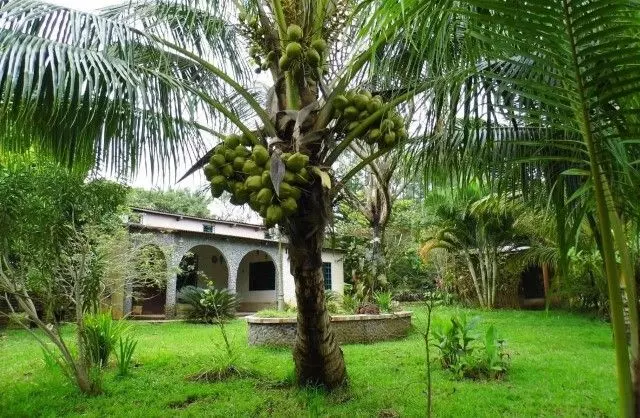
Indoor Palm Trees Care
After knowing these types of indoor palm trees and their names, we recommend you to know a little about how to take care of indoor palm trees:
Lighting: in general, we can say that indoor palm trees need to receive sunlight at least for a few hours of the day. Therefore, we advise you to always place them near a window.
Watering: you will only need to water them at least once a week and use, if possible, lime-free water. The best way is to place a dish with water under the pot for at least 10 minutes.
Fertilizing: We recommend that you fertilize your indoor palms once the growing season begins. This usually includes the months from spring to autumn. Always use natural fertilizers.
Repotting: You should repot every spring. To do this, use a container at least 1.5” (4 cm) wider than the previous one and plant it in a mixture of universal substrate mixed with perlite. Remember that the pot must have good drainage to avoid waterlogging.
Fast Growing Palm Trees in this article.
